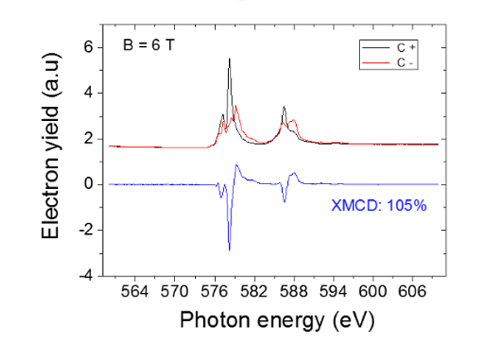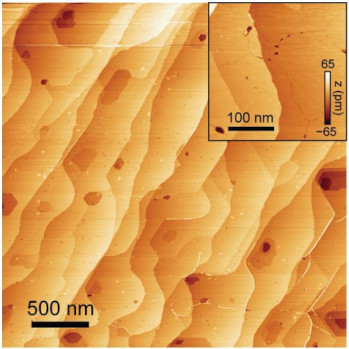Do you want to keep up to date? Subscribe to our newsletter. 1mail every 2months! |
 |


Left: Cr L23 XMCD spectrum of a CrCl3 monolayer at T=2K and B=6T, showing a large magnetic XMCD signal of the Cr atoms exceeding 100% (L3 edge) BOREAS. Right: STM topography of a monolayer CrCl3 grown on Graphene/6H-SiC(0001). Inset, a magnified topography image, which reveals the grain boundaries. MPI. © Science, doi: 10.1126/science.abd5146
Cerdanyola del Vallès, 16th Desember 2021 The thinnest materials in the world are only a single atom thick. These kinds of two-dimensional or 2D materials – such as graphene, well-known as consisting of a single layer of carbon atoms – are causing a great deal of excitement among research teams worldwide. This is because these materials promise unusual properties that cannot be obtained using three-dimensional materials. As a result, 2D materials are opening the door to new applications in fields such as information and display technology, as well as for critical components in extremely sensitive sensors.
Structures known as van-der-Waals monolayers are arousing particular interest. These are combinations of two or more layers of different materials that are each only a single atom thick, with the layers held to one another by weak electrostatic van-der-Waals forces. By selecting the type and sequence of material layers bound in this way, specific electrical, magnetic, and optical characteristics can be chosen and modified. However, scaled-up homogeneous deposition of individual van-der-Waals layers having ferromagnetic properties has not yet been achieved. Yet it is precisely this kind of magnetism on a larger scale that is particularly important for several potential applications – such as for a novel form of non-volatile memory for example.
An international team from the Max Planck Institute for Microstructure Physics in Halle, Germany, the ALBA Synchrotron and the Helmholtz-Zentrum Berlin have now succeeded for the first time in creating a uniform ferromagnetic two-dimensional material and as well demonstrating bidimensional ferromagnets can also exhibit the so far elusive easy-plane magnetic anisotropy. By fine analysis of the magnetization temperature dependence to derive the critical exponents, it was possible to conclude this was a first case of the so-called universality class of bidimensional XY ferromagnets.
A nearly free-floating layer of chromium and chlorine
The researchers from Germany and Spain utilized chromium chloride (CrCl3) as a material, which resembles the corresponding compound made of chromium and iodine in structure – but can be considerably more robust. The team in Halle deposited a macro-scale monoatomic layer of this material upon a graphene-coated silicon-carbide substrate using molecular-beam epitaxy. The purpose of the graphene was to reduce the interaction between chromium chloride and silicon carbide and thereby prevent the substrate from influencing the properties of the monoatomic CrCl3 layer. This was the key to accessing the elusive magnetic easy-plane anisotropy”, explains Dr. Amilcar Bedoya-Pinto, a researcher in Prof. Stuart Parkin’s group at the Max Planck Institute in Halle. “Essentially, we obtained an almost free-floating, ultrathin layer that was only bound to the graphene interlayer by weak van-der-Waals forces.”
The team's goal was to answer the question of how the magnetic order in chromium chloride manifests itself when it consists of only a single monoatomic layer. In its normal three-dimensional form, the substance is antiferromagnetic. As a result, the magnetic moments of the atoms are oriented in opposite directions in each layer – which makes the material appear non-magnetic in bulk. Theoretical considerations so far suggested that the magnetic ordering is lost or exhibits weak conventional magnetisation when the material is reduced to a single atomic layer.
Key X-ray magnetic circular dichroism measurements
However, scientists have now succeeded in disproving this – by taking a detailed look at the magnetic properties of the 2D material. To do so, they used the unique capabilities of the ALBA BOREAS and BESSY II VEKMAG beamlines, where it is possible to investigate magnetic samples using soft X-rays in a strong magnetic field and at temperatures near absolute zero. Using a technique known as x-ray magnetic circular dichroism, it is possible to perform magnetic measurements with higher accuracy and reliability than conventional magnetometry (SQUID) available at Laboratories by exploiting the element specificity enabled by synchrotron radiation to detect the small signal from the atomically thin layer with minimum background. This enabled the team members from Halle to determine the orientation of individual magnetic moments and to accurately distinguish between chromium and chlorine atoms.
During the measurements, the researchers observed how ferromagnetic order formed in the two-dimensional material below a certain temperature, what is known as the Curie temperature. “In the monoatomic chromium chloride layer, a phase transition characteristic of easy-plane magnetic anisotropy magnets took place that had never been observed before in such a 2D material”, reports Bedoya-Pinto.
Tailwind for the development of spintronics
The discovery not only offers new insights into the magnetic behaviour of two-dimensional materials. “We now also have an excellent platform for exploring a variety of physical phenomena that only exist in two-dimensional magnets”, Bedoya-Pinto is pleased to say, such as superfluid (lossless) transport of spin, which is a kind of intrinsic angular momentum of electrons and other particles. These are the basis for a new form of data processing that – unlike conventional electronics – uses magnetic moments rather than electrical charges. Known as spintronics, this is currently revolutionizing data storage and information processing.
Reference: Amilcar Bedoya-Pinto, Jing-Rong Ji, Avanindra Pandeya, Pierluigi Gargiani, Manuel Valvidares, Paolo Sessi, James Taylor, Florin Radu, Kai Chang and Stuart S.P. Parkin. Intrinsic 2D-XY ferromagnetism in a van der Waals monolayer. Science (2021). DOI: 10.1126/science.abd5146
Original news from HZB: https://www.helmholtz-berlin.de/pubbin/news_seite?nid=23222;sprache=en;seitenid=50730
With the collaboration of Fundación Española para la Ciencia y la Tecnología. The ALBA Synchrotron is part of the of the Unidades de Cultura Científica y de la Innovación (UCC+i) of the FECYT and has received support through the FCT-20-15798 project.





